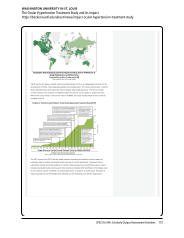SPEC Kit 346: Scholarly Output Assessment Activities · 17
SURVEY QUESTIONS AND RESPONSES
The SPEC Survey on Scholarly Output Assessment Activities was designed by Ruth Lewis, Scholarly
Communications Coordinator & Science Librarian at Washington University Libraries in St. Louis, and
Cathy C. Sarli, Senior Librarian for Evaluation and Assessment Services, and Amy M. Suiter, Scholarly
Publishing Librarian, Washington University School of Medicine in St. Louis, Becker Medical Library. These
results are based on data submitted by 79 of the 125 ARL member libraries (63%) by the deadline of February
17, 2015. The survey’s introductory text and questions are reproduced below, followed by the response data
and selected comments from the respondents.
Research libraries offer substantial expertise in navigating the ever-expanding array of resources that exist to illustrate a narrative
based on scholarly productivity and impact. They help authors manage their profiles on author-based platforms; provide strategies to
enhance discoverability of scholarly works; offer multiple avenues of dissemination for scholarly works; help authors efficiently track
research outputs and activities; provide publication reports and social network maps; provide resources and tools to help authors
assess their scholarly output and impact; and offer training on new trends and ways of reporting of scholarly efforts.
Learning about assessment of scholarly output at research libraries is increasingly critical in light of the changing landscape towards
reporting of scholarly productivity and impact to demonstrate tangible and meaningful outcomes. Traditional measures to quantify
scholarly productivity based on “counts” (number of publications, number of citations, journal impact factor scores, etc.) are
insufficiently robust to meet the increasing demands of accountability and return on investment. Those measures are now being
supplemented with other metrics such as usage or downloads on publisher, repository or other journal platforms; the h-index; or
article-level metrics that represent social or academic engagement. Understanding the full array of newer metrics and how they play
a role in assessment of scholarly output and impact will become increasingly important for research libraries as the metrics become
more widely available and employed by funding agencies, publishers, and academic institutions.
Scholarly output is defined for survey purposes as articles, abstracts, patents, and books or book chapters. Digital technologies
have enabled research outputs and processes that stretch far beyond these print forms. Within the ARL community, the SHared
Access Research Ecosystem (SHARE) is developing a working definition of research processes and outcomes that includes the
following scholarly outputs: publications, conference materials, intellectual properties, digitally-enabled forms including datasets,
software, databases, and hybrid and emerging forms such as web-based narration, interactive sites or scripted events, websites,
heterogeneous digital objects, and a range of media beyond print and static images. Respondents should feel free to consider these
examples of scholarly outputs while answering the survey questions.
The purpose of the survey is to identify current research library practices, activities, or programs related to assisting scholars or
researchers (individual and/or groups) with scholarly output assessment. The survey covers services and resources, training, staffing
models, partnerships with the parent institution, marketing and publicity, and future trends.




























































































































































































